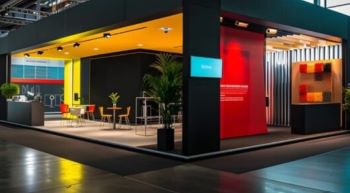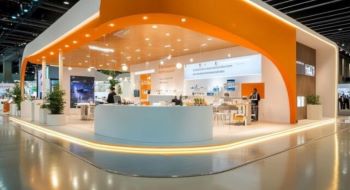
Reusing is always the goal, and disposing is the last resort. When you’re designing the trade show booth while focusing on being environmentally conscious, trade show rental booths are a great option. These booths can be rented for a more affordable price than investing in one. Furthermore, used trade show exhibits are far more eco-friendly than purchasing or customizing a new one for every trade show.
Five Ways Sustainability is Transforming Exhibit Design in 2026

- Reusing and Reinventing Custom Trade Show Exhibits
The recycling of custom trade show exhibits has been regarded as a sustainable form of innovation. Exhibitors—rather than simply discarding materials after one use—are reusing and repurposing existing booth parts in new and innovative designs. Modular frames, flexible lighting, and interchangeable graphics provide exhibitors the opportunity to easily upgrade their exhibits for new shows while still making a compelling visual statement. Creative reimagining of older designs also saves on the costs and materials of creating new exhibits while still presenting a booth that looks fresh and is representative of their brand. This approach is meaningful for both sustainability principles and communicating authenticity and longevity.
- Circular Economy Practices and Post-Show Reuse
The notion of sustainability does not stop when the event is complete. A circular economy promotes the constant reuse, recycling, or repurposing of both. Companies are beginning to manage their materials, storing, reusing, and repurposing them for future shows or sharing them through rental programs. This ray of light can help keep waste from the landfill while creating collaboration within the exhibition industry. Exhibitors, in some cases, will go so far as to donate items to community projects or creative workshops once the event is over, and allow each piece of material to have a new purpose and new life. The philosophy of “Waste not, Want not” is developing into a new standard of environmentalism in the trade show space.
- Incorporation of Recycled and Recyclable Materials
The selection of materials plays a significant role in shaping the sustainability of modern exhibition design. Aluminum, reclaimed wood, and recycled plastics are popular materials being used to create booths. In addition, graphic fabric produced from recycled PET bottles and printed with environmentally friendly inks is used to create attractive graphic displays that are sustainable compared to traditional fabrics. These materials provide structural integrity and aesthetic quality, allowing the exhibit to present sustainability alongside design. The result is an exhibit with visual appeal that leaves a lighter environmental footprint before, during, and after the exhibition.
- Energy-Efficient Lighting and Technology Integration
Another factor affecting the trade show world in 2026 is energy-efficient technology. LED light fixtures, smart sensors, and energy management technology are now used to improve booth efficiency while lowering electrical consumption. Some booths even feature solar charging units for interactive screens or digital displays, highlighting energy independence. These technologies not only improve the sustainability of operations and reduce energy consumption, but they also offer the visitor a much more enriched experience with interactive storytelling and aesthetically appealing graphics. It is the balance of energy efficiency and interactive experience that defines today’s sustainable booth practice.
- Modular Design for Flexibility and Longevity
The concept of modularity drives the advancement of green exhibits. Modular exhibits are scalable; the identical components can be used in various configurations and installations for all sizes and types of events, thereby eliminating the need to construct new exhibits. Every modular item can be adjusted, increased, or decreased in size as needed, allowing exhibitors to flexibly adapt at shows they have to attend multiple times a year. In short, because display components are typically high quality with long use cycles, the idea of modularity promotes longevity through chassis design; with even minimal refurbishing, most exhibit components will easily last several seasons. The modular approach effectively brings together functionality, beauty, and sustainability.
End Point
The move toward secondhand and rethought exhibit designs signals an important shift within the tradeshow industry. The emphasis will be less on spectacle and more on substance, where creativity meets purposeful design and responsible production. Sustainable options such as modular design, recyclable materials, and technology that reduce waste are rejigging the way brands show themselves on a global scale. Whether exhibit designs are borrowed, reused, or brought to life via trade show rental booths, the fall of 2026 is going to be filled with one message: sustainability and sophistication can coexist beautifully. This transformation will not only enhance our focus on environmental stewardship, but it will also launch us into a new world of purposeful and enduring design.
 Newspatrolling.com News cum Content Syndication Portal Online
Newspatrolling.com News cum Content Syndication Portal Online







